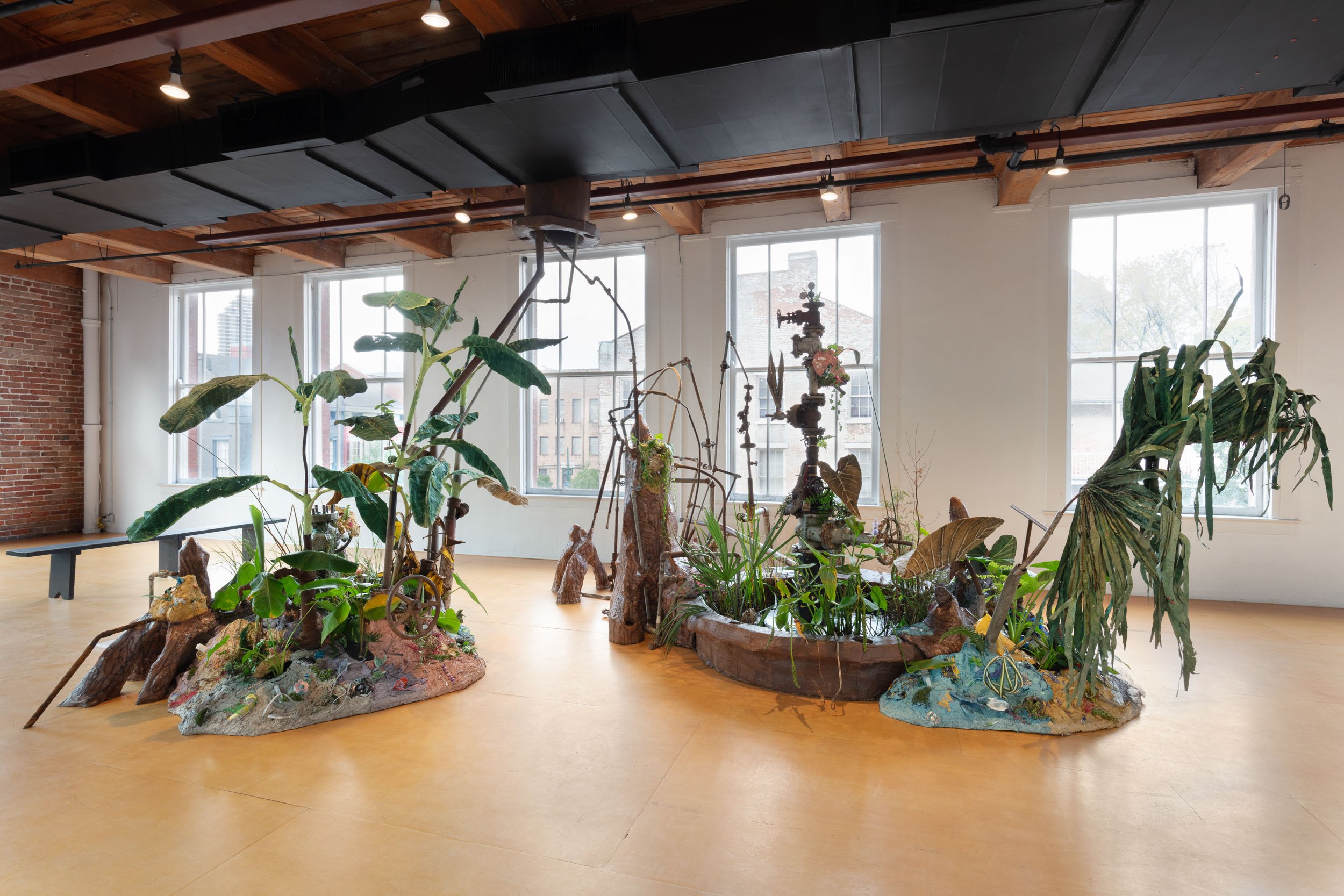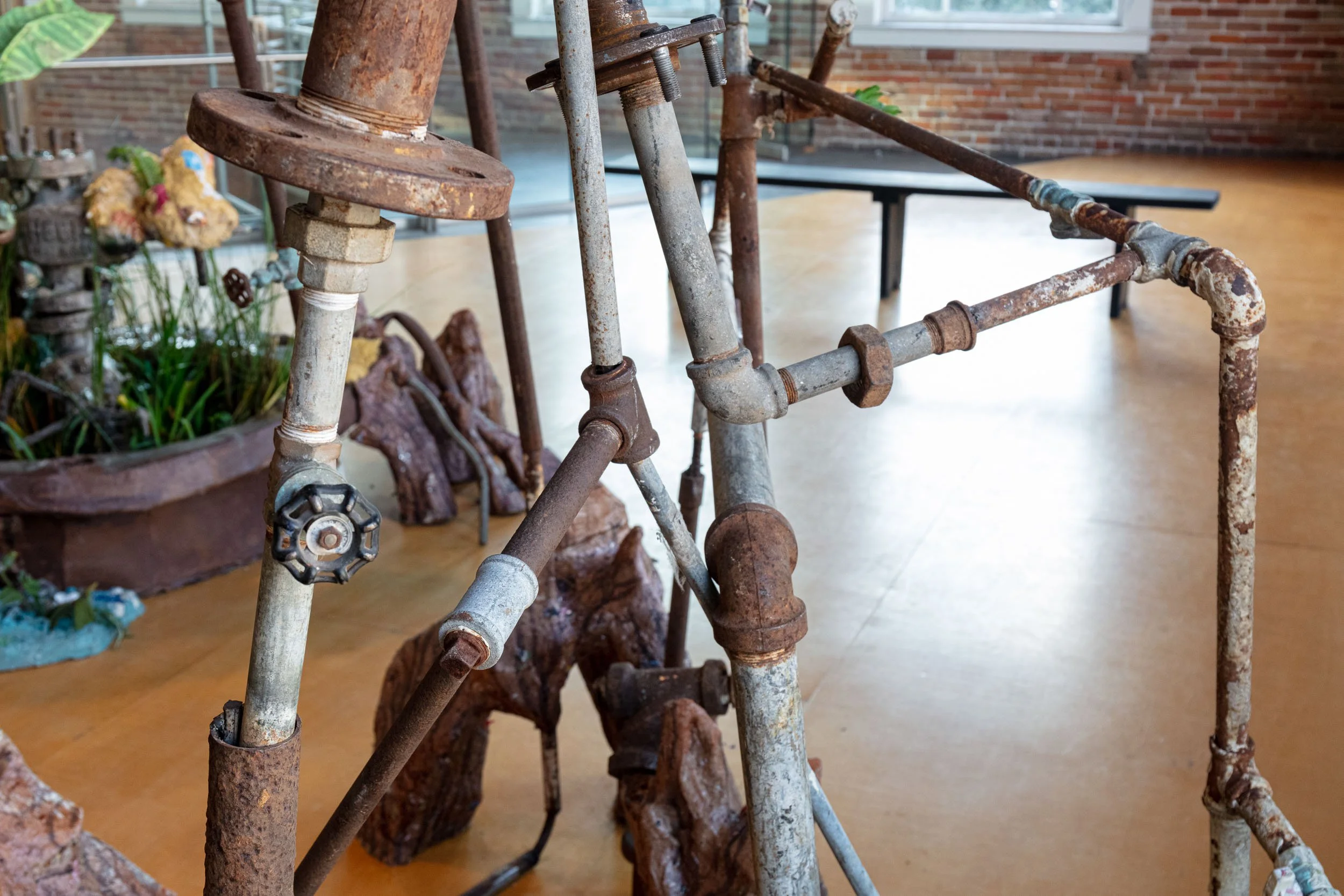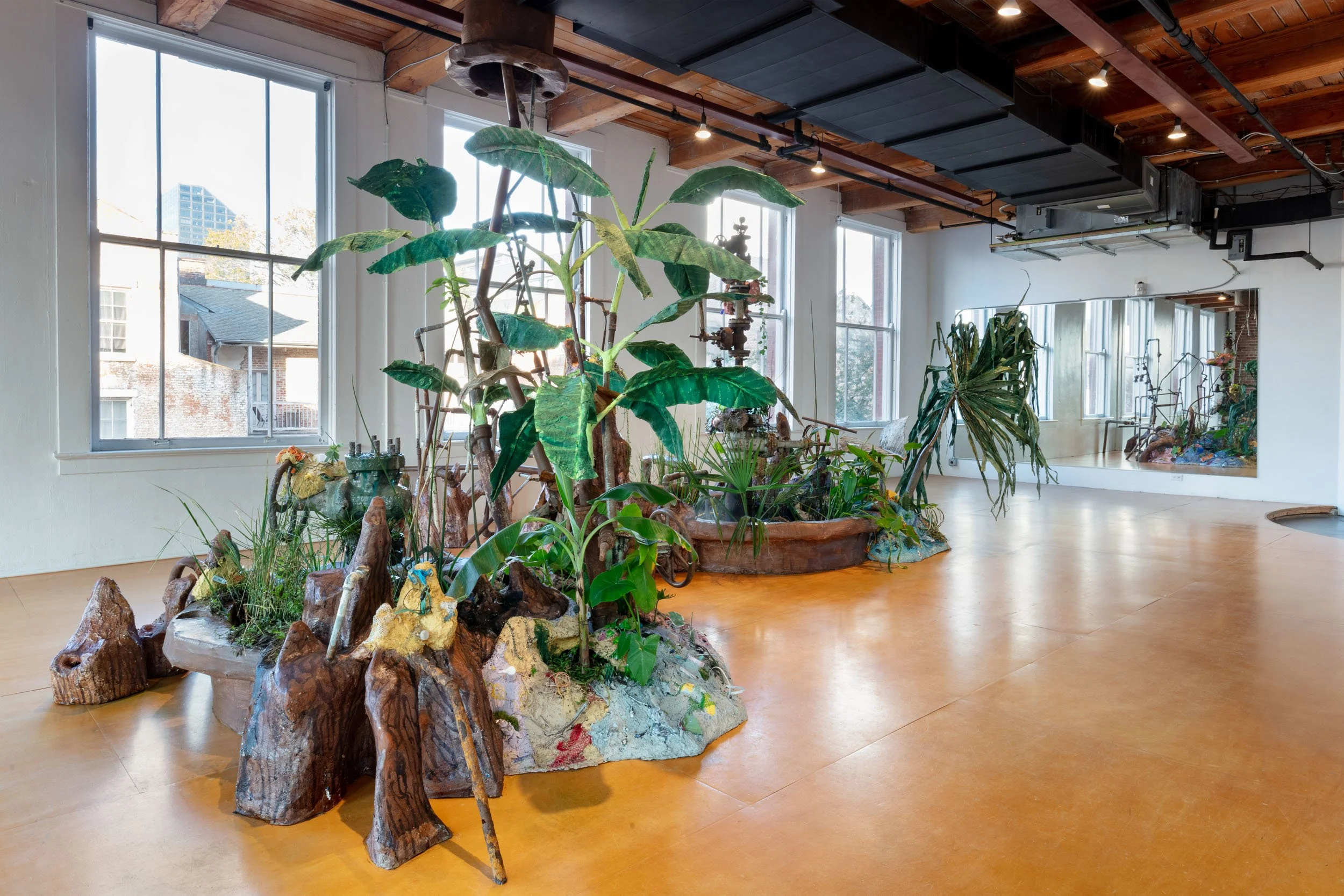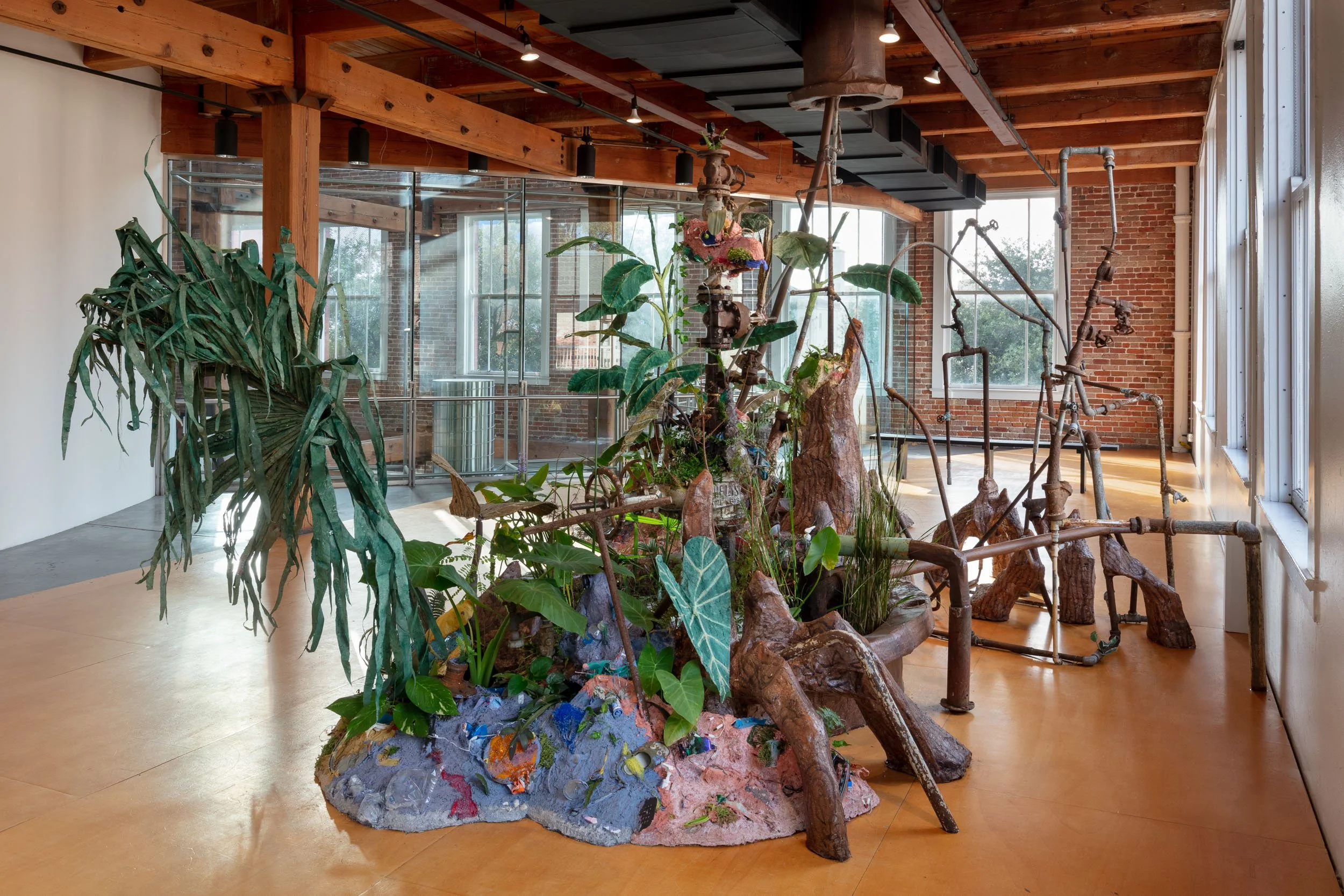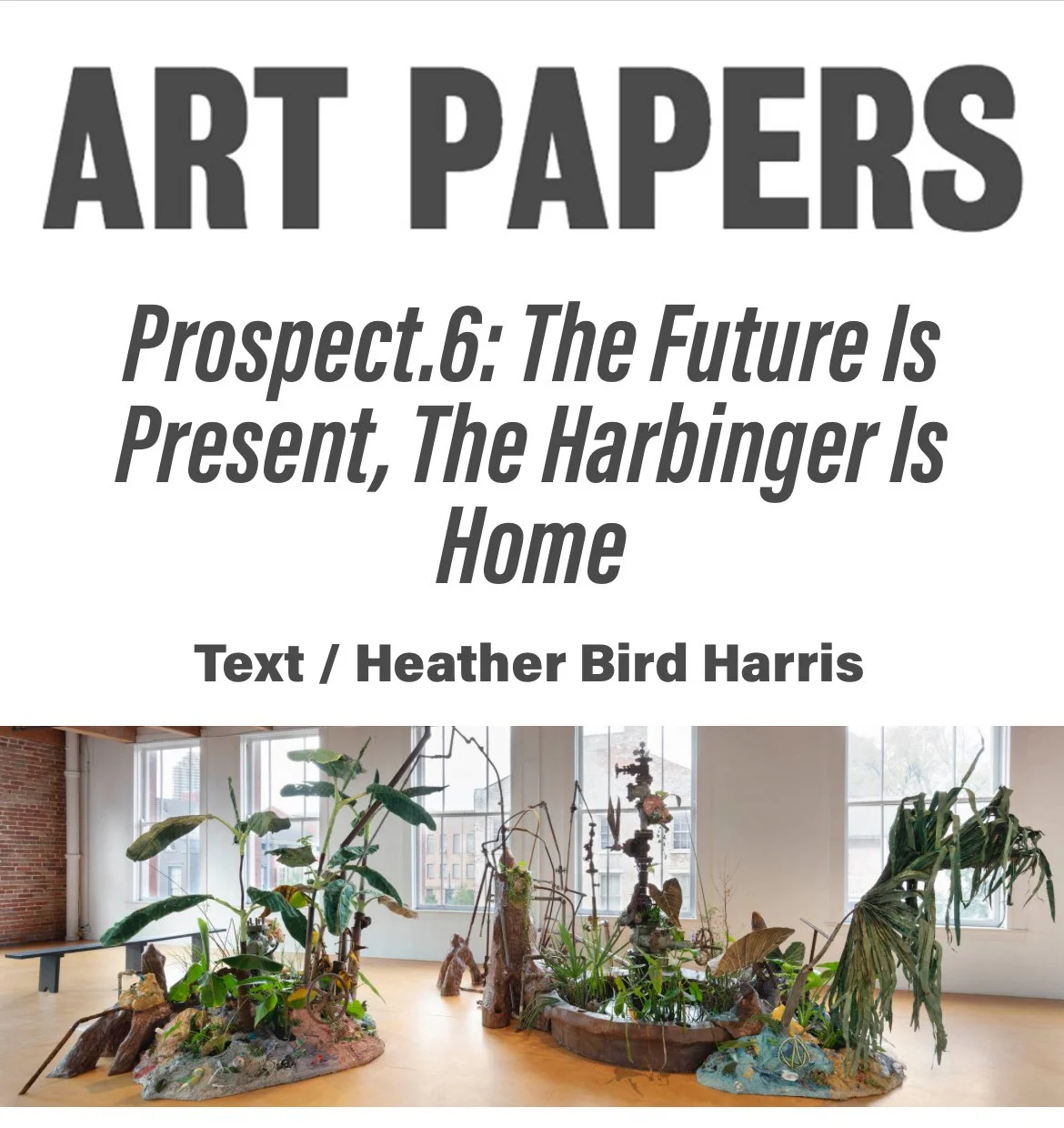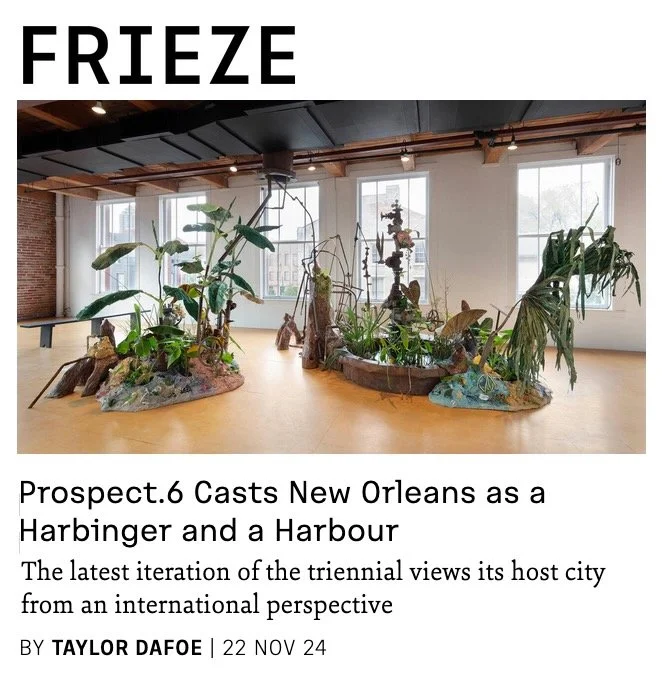Orphan Well Gamma Garden
Metal, sugarcane, disposable plastic waste, lime, recycled paint, paper made from sugarcane combined with shredded disposable plastic waste ("plasticane"), ink made from persimmon, goldenrod, indigo, copper and oak galls, pumps, irrigation tubing, diffuser, "fertile rot" scent, living plants, soil, and water
2024
Commissioned for Prospect 6 New Orleans at the Contemporary Arts Center, New Orleans
Video documentation by Varvara Degtiarenko
This immersive installation investigates the long-lasting impact of oil and gas industry pipelines on the Southern Louisiana landscape and its people. I created my own wellheads by stacking found oil and gas valves that become nourishing fountains for living plants. This lush indoor garden also contains sculpted plants made from "plasticane" —a material I create by mixing shredded reclaimed plastic with bagasse, the fibrous waste product created after processing sugarcane into juice. I worked with perfumer Jane Bleeker to create the scent “Fertile Rot” for this installation, which lingers around the plants and water mimicking the sweet, fermented odor of the swamp.
The title of the work refers to jarring environmental issues plaguing Louisiana's wetlands; the threat of carbon capture and this largely unproven technology’s dangerous connection to Louisiana’s thousands of orphan wells, abandoned fossil-fuel infrastructure that can be radioactive. When oil wells are no longer financially lucrative, they are often “orphaned,” and equipment is left in the environment to leach toxins. When these toxins are radioactive, the wetlands become unofficial gamma gardens-a term that evokes Atomic Era experiments that produced genetically modified crops and might portend the future of this landscape if we don’t change course.
The wellheads in the installation are branded "Helis Oil + Gas” a reference to the Helis Foundation (THF), a major funder of P.6 and most of New Orleans major arts institutions. THF is a private foundation in New Orleans whose Arts Fund was established by family members of William G. Helis, founder of what is now known as Helis Oil and Gas Co. Helis Oil and Gas Co. is a privately owned oil and gas company whose President is also the President of THF. Today Helis Oil + Gas no longer operates wells in Louisiana but maintains fossil-fuel infrastructure in Texas, Montana and North Dakota, while THF uses philanthropy to distract from the company’s environmental impact rather than taking accountability and using its assets to mitigate the effects on climate change. Through its continued investment in fossil-fuel extraction Helis Oil + Gas is actively making the future of New Orleans more precarious, while THF, which operates out of the same address and shares the same President and Vice President, funds the arts.
Community Carbon Off-Sets for this Installation:
I worked with the organization Artists Commit to create a climate impact report (CIR) for this installation that tracked the carbon emissions from the materials and their afterlife, production, shipping and energy use of the exhibition. Based on these metrics, I calculated that the carbon cost of OWGG to be 2.5 tons of CO2 and used my CIR as a guide for a community carbon offset project to sequester the carbon emitted as part of my installation which is an essential part of the artwork itself.
For the community carbon offset I’m working with Jacqueline Richard and Richie Blink, who are restoring 10.5 acres of former cattle grazing land to coastal wetland forest in Plaquemines Parish, a 1.25 hour drive down the Mississippi River from New Orleans. They call the land they are stewarding Maktub Forêt. Each season, Richard and Blink are raising thousands of cypress seedlings to be planted in the Forêt.
For the off-set project, I invited the public to join me in planting cypress seedlings in the ground. In March 2025, together with a group of nine volunteers, we planted 110 baby cypress trees in the ground which will offset the 2.5 tons of carbon emissions in 16.6 years. This is a new model for me and its important for me to bring the public in to hold me accountable and also to think together about the carbon costs of our activities and their long-term implications. Just as OWGG envisions the afterlife of the oil and gas industry, planting these trees is a commitment to the afterlife of the installation, as these saplings spend the decade and half plus years growing needed to offset the emissions of my artwork—becoming mature cypress trees and supporting the resilience of our coast.
Special thanks to Artists Commit for providing a materials stipend which I used as a honorarium to Richie + Jacqueline for the long-term materials, care and time commitment needed to ensure these trees survive and thrive long enough to offset the emissions from my installation.
Exhibition Credits:
Co-Artistic Directors: Miranda Lash + Ebony G Patterson
Exhibition Manager: LB Barfield
Programming Director: Denise Frazier
Exhibition Coordinator: Devin Balara
Exhibition Preparator: Sam Hollier
Production Assistants: Julian Jefferson, Eden Chubb, Maddie Stratton, Ari Chalew
Plumbing + Plant Guidance + Install: Joe Evans and Evans + Lighter Landscape Architecture Plant Donations: CRCL, Louisiana Iris Conservation Initiative
Custom scent Fertile Rot: Jane Bleeker of Hazeltine Scent Co.
Paint Donations: The Green Project New Orleans
All the friends that donated brown paper bags
Install: Maddie Stratton, Camille Lenain, Aaron, Dom, Eli, Kevin, Sam S.
Venue: Contemporary Art Center New Orleans, Schuyler Williams, Josh Casimier, DiQuan Forcell and all the gallery guards and staff
Maintenance of Installation: Benny Brown
De-Install Crew: Margot, Meredith, Stephen, Ben + Dom
Carbon Offset Land Stewards: Jacqueline Richard + Richie Blink
Tree planting volunteers: Manon Bellet, Margot Herster, Dan Charbonnet, Rebecca Diaz, Halle Parker, John MacMurray, Henry
Childcare support: Cypress Atlas, Gail + Stuart Chalew, Lois + Mark Langberg
My family for their endless support: Sam Langberg + Izzy + Lev Langberg-Chalew
Press for Orphan Well Gamma Garden
Mention of my work in Ben Sutton’s The Art Newspaper review of Prospect 6:
“The Baltimore-born, New Orleans-based artist Hannah Chalew & has transformed one of the often forgotten features of Louisiana's landscape, oil and gas infrastructure, into the basis for an indoor fountain. Her installation Orphan Well Gamma Garden (2024) is fashioned from a material she calls "plasticane"-a mix of shredded plastic waste and bagasse, the byproduct of processing sugarcane into juice-and also includes a salvaged oil wellhead, plants native to southern Louisiana and the artist's custom scent, dubbed Fertile Rot, which is based on the odour of the gasses generated by swamps.
The artist has pointedly emblazoned the base of the wellhead with the words "Helis Oil & Gas", a reference to an oil and gas extraction company based in New Orleans whose non-profit arm, the Helis Foundation, is a major funder of the arts in Louisiana (and one of the biggest supporters of this edition of Prospect, though crucially not of Chalew's commission). "Our economy is so entrenched in the oil and gas industries, but so is our culture," Chalew said during a panel last autumn. "They're distracting from what they're doing rather than working to make it better." “
Featured in Heather Bird Harris’ deep dive into P.6 for ArtPapers:
Hannah Chalew’s installation Orphan Well Gamma Garden imagines a landscape where cypress knees and plant life have reclaimed southern Louisiana. Filling an entire room in the Contemporary Arts Center, the installation features islands of living plants; discarded oil and gas pipes; and sculpted forms made from “plasticane” paper, a material Chalew invented from shredded plastic and sugarcane fibers. These handmade forms encase the unavoidable plastic remnants from Chalew’s life as a young mother—Covid tests, pacifiers, sippy cup tops, and breast pumps—like fossils, preserved within the plasticane. At the installation’s center, a salvaged oil wellhead is transformed into a fountain, spilling black water that eerily sustains the plants, while the faint drip of a leaky pipe underscores the environmental damage left by abandoned oil wells. Chalew’s work posits that these wells, often leaching radioactive toxins for decades, turn wetlands into “gamma gardens,” a term recalling Cold War–era experiments in which plants were intentionally mutated by radiation.
Notably, Chalew added a HELIS logo on the wellhead as a direct critique of the Helis Foundation, a major funder of Prospect. Helis is deeply entrenched in the oil and gas industry, operating wellheads in the Gulf and participating in fracking. Chalew’s work calls out the artwashing practices of corporations that prioritize profit over meaningful environmental repair. A key part of Chalew’s practice is to avoid taking funding from such organizations, which is unfortunately difficult to sustain in the art world. “It’s the existential issue of our time,” Chalew asserted at a panel during opening weekend, urging genuine accountability for these corporations rather than allowing them to distract from their impact.
Allison Young mentions my work in her ArtReview review of Prospect 6:
”… Hannah Chalew's sprawling sculptural installation Orphan Well Gamma Garden (2024), at the Contemporary Arts Center, conjoins scavenged pipes, live plants and single-use plastics into a dystopian, posthuman landscape.”
Taylor Dafoe mentions my work in his Frieze review of Prospect 6:
”New Orleans-based artist Hannah Chalew has refashioned an old oil wellhead into a working fountain enlivened by plants – an instrument of extraction turned into a site of regeneration (Orphan Well Gamma Garden, 2024).”
